Università Del Caffè USA. Learning to Make Good Espresso and Cappuccino with illy
Where can one learn the art of the barista and how to make the perfect espresso and cappuccino? The answer is easy: at the Universita del Caffè USA.
The Università del Caffè was created in Naples in 1999 by illy caffè. Its purpose is to promote and disseminate the culture of quality coffee using specific theoretical and practical activities. It offers a wide range of courses tailored to meet the needs and characteristics of various types of users: managers, bartenders, restaurant owners, hotel managers, coffee growers and consumers. This program is so sucessfull that there are now 19 international UDC sites.
The illy Company was founded in 1933 by Francesco Illy in Trieste, Italy. Two years later, he created the “illetta”, an automatic espresso machine that substituted compressed air for steam and created the modern espresso machine that we use today.
I first tasted illy caffè in Trieste in 1994 and was amazed by how good it was. Even though it was very hard to find in the US, my wife Michele wrote about it in her dessert cookbook “La Dolce Vita”. On our next trip to Trieste, we arranged to visit the illy factory and were greeted by the late Dr.Enesto Illy, the son of the founder, who took us on a tour. I have been hooked on Illy caffè ever since. The Illy family still runs the company and in 2005, Andrea Illy, grandson of the founder, became the Chairman and CEO.
I have been making caffè and cappuccino at home for many years. It is very good but not as good as I have had in Italy, especially in Trieste and Naples. I have a restaurant espresso machine and I use illy caffè. But what am I doing wrong? I hoped I would find the answer at the UDC.
The course I went to was held at the International Culinary Center in New York. It was a two day course given on Monday and Tuesday from 9:00 AM-5:00 PM. There were about 30 people taking the course and they came from all over the country. When I walked into the classroom there was coffee, coffee everywhere and all you could drink.
There were two instructors from illy headquarters in Italy: the very knowledgeable and entertaining Moreno Faina, a Specialty Coffee Association of Europe Qualified Instructor; and Giorgio Milos, illy’s Master Barista, also certified by the SCAE. He is the man that has mastered the art of coaxing the beans into a brilliant cup of pleasure.
The third was someone that I have known for many years David Rosengarten, an authority on wine, food, and cooking, and a very entertaining speaker. David was the first to speak and also acted as a sort of moderator. He spoke about the history of coffee and told us that it may have started in Ethiopia or Central Africa, that it was first brewed in Yemen, how it came to be called coffee and its introduction into Europe by the Turks.
In order to understand what a good caffè should taste like, we tasted a number of different coffees and in some cases tried to identify the components. The first coffee we tasted was Turkish and I found it very rustic and heavy.
Next a terroir tasting: Ethiopian, Brazilian and Sumatra coffees. I found only slight differences between the three.
Next we had to try and guess the different aromas and tastes in the coffee.
We were given 3 cups of coffee. Two were the same and one was different. All you had to do was pick out the two that were the same from the one that was different. For example two cups were 100% Arabica beans and one a blend of Arabica and Robusta. First you had to say which were the same and then if they were the Arabica or the blend. This I was able to do.
Next there was a discussion on decaf coffee. Signor Faina asked if anyone could tell the difference between regular and decaf. Many in the class said they could. He said that it was difficult to tell the difference between Illy regular and Illy decaf. We tasted both and less than half the class could tell the difference. Signor Faina said that on average only 20% could tell the difference.
Lastly was the extraction time. Is the coffee over-extracted (watery) or under-extracted (acidic). I was right on the money here because my caffè is usually one or the other, so it was easy.
Then we learned about the beans. There are two main types of coffee beans: Arabica and Canephone which produces the Robusta variety. Arabica is grown in the highlands and is considered to have more flavor, aroma, complexity and balance than the harsher Robusta. We were told by Signor Faina that his company produces and sells worldwide a single blend of premium quality espresso coffee made of nine varieties of pure Arabica. He went on to say that the unmistakable and invariable illy taste and aroma, enjoyed cup after cup anywhere, all over the world, are the results of a perfect balance of beans coming from South America, Central America, India, and Africa.
There are machines that can sort the beans by weight, color, ripeness and size. illy even has a machine that can remove the defective beans. In some countries this is still done by hand. Each student received a cup with 50 beans, five were “bad”, and we had to pick out the five. I found three right away: the whitish bean, the black bean and the dark waxy bean. But it took me sometime to find the immature and the light waxy bean. One bad bean will ruin the coffee.
Mr. Faina said that over roasted beans were not good. As he put it, “be afraid of the dark.”
illy has only one factory and all the roasting is done here. Mr. Faina said that if the beans are lightly roasted, the coffee will have more acidity, be light bodied and less bitter. A medium roast gives more acidity, more body and aroma. This is the type of coffee that is preferred in Northern Italy. For Southern Italy, illy uses a darker roast; it has less acidity, a little more bitter and a certain roundness and smoothness. It is all a matter of taste.
illy also sells ground espresso coffee in the pressured cans for freshness. There are special grinds for the espresso machine, Moka coffee for the stovetop coffeemaker, and another for the drip coffee maker. They also make coffee pods which give you almost perfect espresso every time. As would be expected, they make a very good line of espresso machines.
Signor Milos talked about the grinder. He said the grinder is more important than the espresso machine. It is 55% grinder and 45% espresso machine. If the grind is too fine, the water will take too much time to pass through (under extracted). If the grind is too coarse, too much water will pass through (over extracted). A grinder that has a slower blade speed is better because it makes less heat. During the course of the day, the barista may change the setting on the grinder 5-10 times to get the perfect flow: 25-30 seconds.
The Art of the Barista/Making the perfect “caffè Espresso"
As the name indicates, an espresso is a cup of coffee prepared on the spot for immediate consumption. When brewed properly, it is an enormously complex drink with concentrated flavors and aromas that distinguish it from coffee prepared by any other method. Espresso is an extraordinary beverage and, like all extraordinary things, is very complicated in his structure. First of all, it is a solution, because it contains different elements (acids, proteins, sugars, fats and others substances). It is also an emulsion, due to the presence of oils, which hold aromas and give espresso his full body. Finally, espresso is a suspension, for the thick and persistence layer of foam (crema) that you can find on the coffee surface. To coffee connoisseurs, espresso is the quintessential form of coffee; the purest way to enjoy its aroma and flavor at their maximum intensity.
It takes 50 coffee beans, nine atmospheres of pressure, seven grams of coffee, and 25-30 second of extraction to create an espresso of 25-30 ml volume. Espresso should never be made one at a time. It is always better to make two cups. The cups should always be preheated. 14 -15 grams of coffee is then needed. Ideally, the coffee beans should be ground only as you need them. Two hours after grinding, 50% of the aromatic components are lost. The coffee must be pressed into the holder with a tamper at 40 lbs of pressure. The water temperature should be about 195 degrees and it should take about 5 seconds for the coffee to begin to flow. The cake of ground coffee is highly resistant and only the acidic elements will pass through. During the next 20-25 seconds, the cake softens and the full range of elements flow through. After 30 seconds you get a bitter, watery cup.
Never, never, never put lemon peel in your caffè (espresso)
Espresso has less caffeine than brewed coffee.
Coffee, especially espresso may have some heath benefits.
Cappuccino
Always steam the milk before making the espresso. A cup of cappuccino should be about 150ml, containing one espresso coffee and equal parts of steamed milk and froth. Fill the third part of a metal steaming pitcher with cold milk. The consistency of the froth will vary depending on the fat content of the milk. Whole milk will produce a very creamy, thick, velvety froth while 2% milk produces a less dense and somewhat stiffer froth. Non-fat milk yields a large volume of stiff, meringue-like froth that dissipates quickly. Whole or 2% milk is recommended for the best flavor.
Turn on the steam for a second or two to release any excess condensation.
Submerge the tip of the steam wand below the milk's surface and begin steaming. As the foam rises and the milk's volume increases, slowly lower the pitcher so the tip remains submerged in the milk. Keep the wand steady and parallel to the side of the pitcher and do not move it around in circles or up and down.
As the milk begins to heat, tip the pitcher slightly to create a whirlpool effect in the milk. This will help inject air for volume and build the froth. Steam until the milk has doubled in volume and the side of the steaming pitcher feels too hot to hold. If you are using a thermometer, stop steaming when the milk temperature reaches 65°C. You can tap the pitcher on a counter to eliminate any large bubbles that may have formed.
You should always make two cups of espresso even when you are having cappuccino.
Mr. Milos also used two pitchers. After he eliminated the bubbles, the milk had a silky look. He poured some of the foam into the second pitcher. He poured the milk from the first pitcher with one motion into the center and by moving his hand was able to make different designs. He poured the rest of the milk from the first pitcher into the second tapped in on the counter and repeated the posses.
He prepared the espresso and poured the steamed milk over it. When done, run steam through the steam wand right away to flush out milk and prevent future clogging.
Each student made espresso and cappuccino under the direct guidance of Mr. Milos. He held each student’s hand as we steamed the milk and then added it to the espresso pouring the milk directly into the center of the cup in one motion and moving the wrist to make a design. Even mine looked good. The examples Mr.Milos showed us were works of art.
Mr. Milos and Mr. Faina gave the class some hints on ordering caffè in Italy. Always say caffè when you are ordering espresso. Never order a lungo or a doppio. In most cases they will just let the machine run longer and you will get an over-extracted bitter, watery coffee. If you order a ristretto, short coffee, it should still take the same 30 seconds for the caffè to be done. If it is cold order caffè corretto (corrected coffee). The barista will add a little grappa.
You should always make two cups of espresso even when you are having cappuccino.
Never order cappuccino after lunch or dinner.
It takes three years of study to become a coffee sommelier or as the Italian say- barista. I just received my Certificate of Completion from the Università Del Caffe USA. Both my caffè and cappuccino have improved greatly. illy gives different courses at the UDC and I am looking forward to taking all of them.






























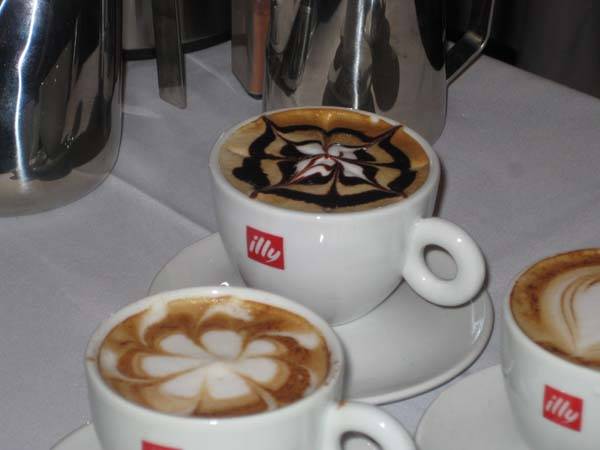
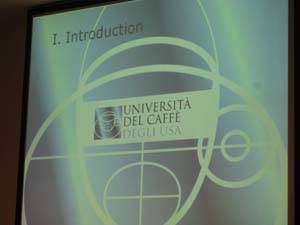
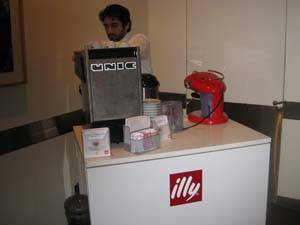
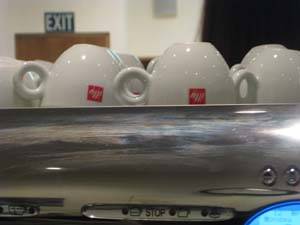
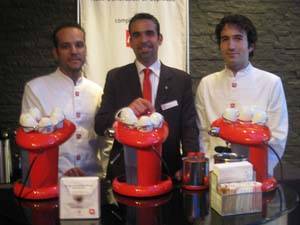
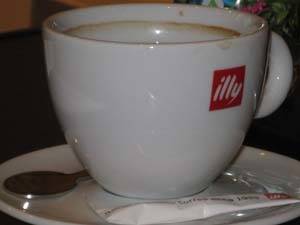
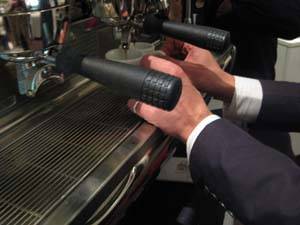
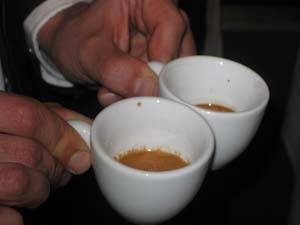
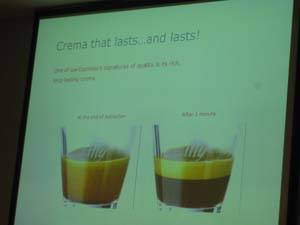
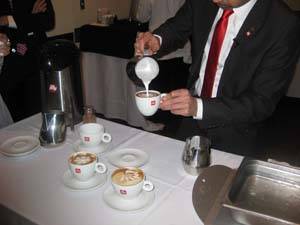
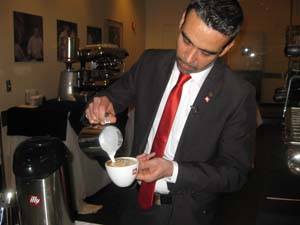
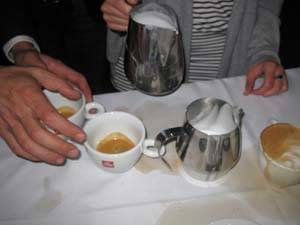






i-Italy
Facebook
Google+
This work may not be reproduced, in whole or in part, without prior written permission.
Questo lavoro non può essere riprodotto, in tutto o in parte, senza permesso scritto.